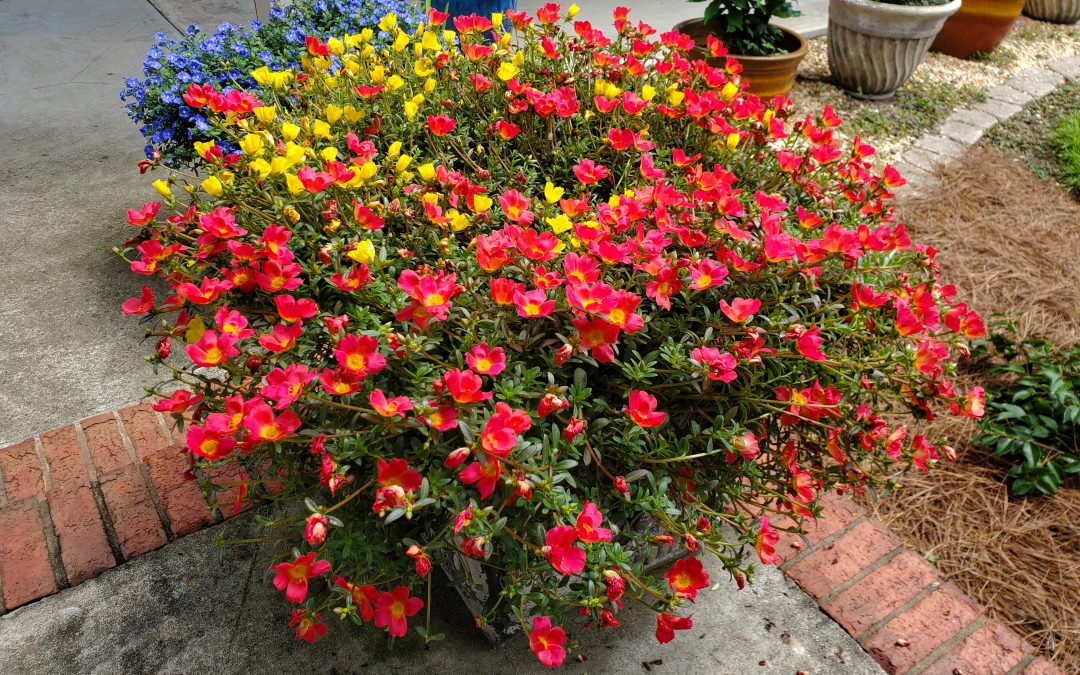
by Daniel J. Leonard | Jul 27, 2022
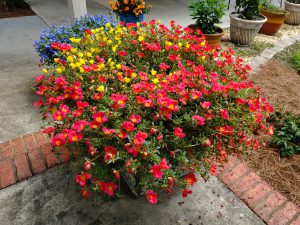
Purslane on a Calhoun County back porch. Photo courtesy of Daniel Leonard.
The biggest problem folks have with flowering potted plants in the heat of summer is remembering that they need water, lots of it. One way to work around having to remember to water every single day is to plant something that doesn’t like too much water but still can churn out a great daily flower show. For this job, there’s only one choice, Purslane (Portulaca oleracea).
Purslane is a super showy, low-growing, succulent-type annual that loves it hot and a little on the dry side. If planted in the ground, it will form a 6-8” tall flowering carpet over the surface of the soil, but I think it really shines when allowed to fill and then spill over the sides of a container! Individual purslane flowers close shop for the day in late afternoon, but cheerily pop back open as soon as day breaks the following day. For best results, make sure the container you plant in has ample drainage holes in the bottom and fill with a quality, quick-draining potting mix. After planting, top dress with a slow-release fertilizer according to the label rate and water only when the soil begins to dry out (every other day or so, generally). Plant a Purslane today!
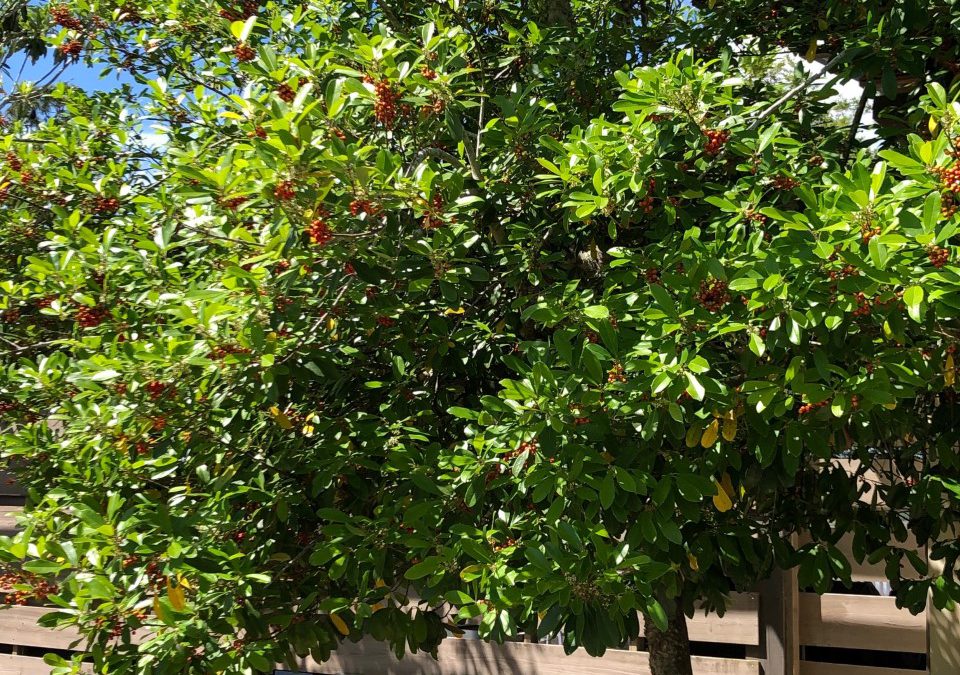
by Stephen Greer | Jun 29, 2022
There are many considerations to make when landscaping with small trees (under 20 feet) in the landscape that are not suitable for large trees. Some of the trees discussed can at times be considered large shrubs depending on definitions and opinions. For the purpose of this article, if it reaches 15 to 20 feet consider it a tree.
Choosing small trees for the right setting involves a number of reasons that could include the need for more privacy from other homes, use as a sound barrier from busy roads, hiding your utility area of the landscape or something unattractive nearby and making sure power lines are not obstructed. Other considerations might include soil types, drainage and holding capacity of the soils, irrigation needs, rate of plant growth and maturity height at 20 feet. Below are a few to consider for the Panhandle of Florida.
Little Gem Magnolia (Magnolia grandiflora ‘Little Gem’) and Teddy Bear Magnolia (M. grandiflora ‘Teddy Bear’) are strong hardy plants once established (within the first 6 months to a year). Both are evergreen with dark green foliage. The ‘Little Gem’ will grow to 20 feet tall by 15 to 18 feet wide. As it matures it tends to become more open and less dense which adds a nice character to show parts of the lower limbs. The ‘Teddy Bear’ will grow to 18 to 20 feet tall but at an even slower rate of maturity to 12 to 15 feet wide while maintaining its density of foliage from bottom to top. It may take a little work to locate the ‘Teddy Bear’ Magnolia.
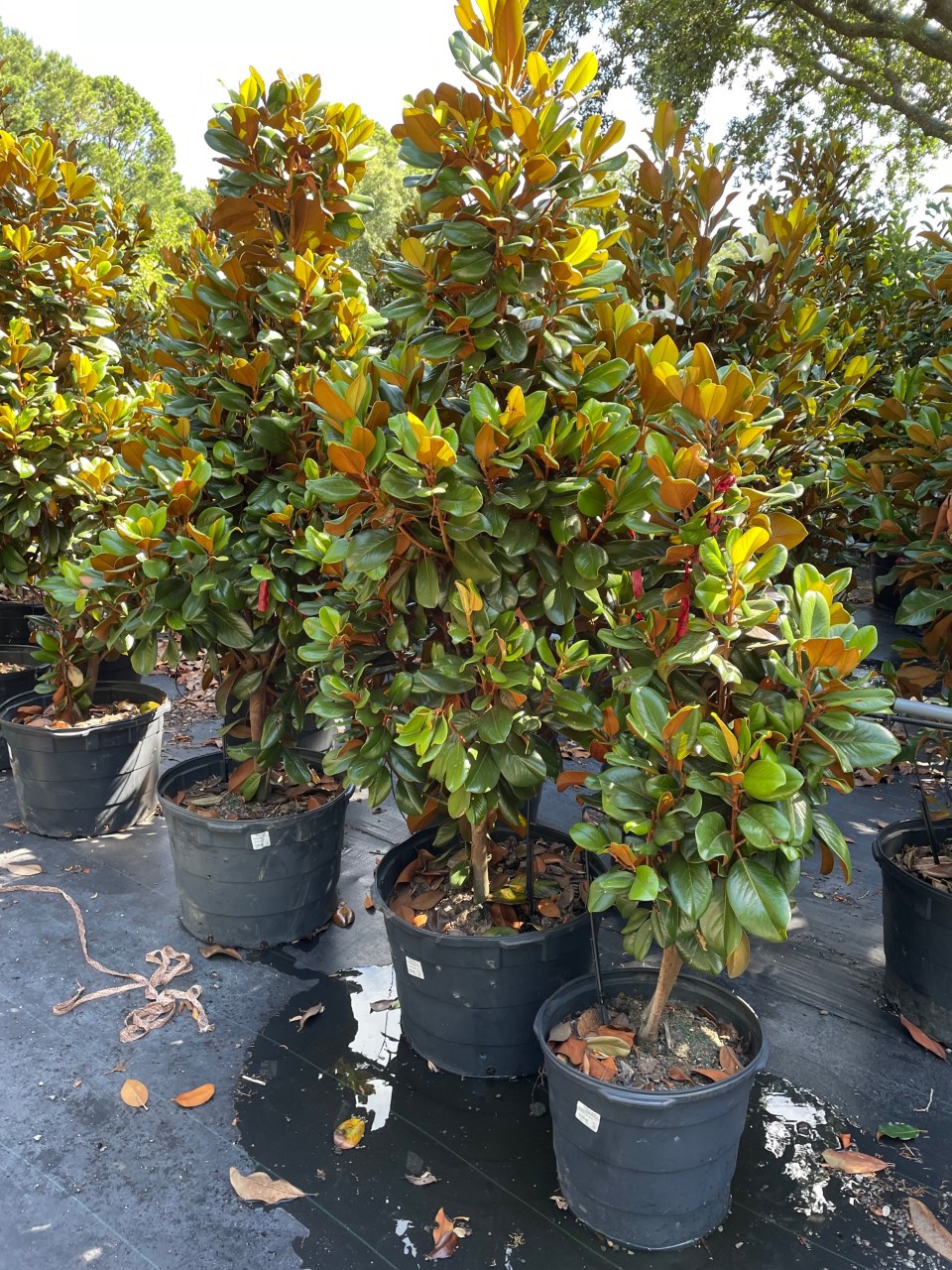
Photo courtesy: Stephen Greer Teddy Bear Magnolia (Small compact grower)
Several hollies to consider would include the Cassine Holly ‘Tensaw’ (Ilex cassine ‘Tensaw’) and American Holly (Ilex opaca). Both are evergreen and produce red berries during the fall that are bird favorites. They have similar heights of 15 to 20 feet and widths of 10 to 12 feet. Pruning can assist in shaping and slowing these measurements, but keep in mind this will change the look of the tree and create a more formal plant presentation.
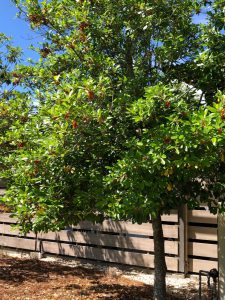
Photo courtesy: Stephen Greer Cassine Holly ‘Tensaw’
The Fringe Tree (Chionanthus virginica) has been a popular tree southeast U.S. for many years. It brings a bright spot to the landscape with white flower panicles that cover the tree in mid to late spring depending on location. For a full color effect, plant it with an evergreen hedge behind it. This oval deciduous tree will grow to 12 to 20 by 10 to 15 wide. The dark blue fruit appears in the fall and serves as good bird food source. This fruit is usually hidden behind the foliage. There might even be a nice yellow leaf change in the fall if temperatures and weather allow.
There are so many more trees to discuss and limited space to discuss them. Visit your local UF IFAS Extension office for additional assistance or visit the UF IFAS online for additional articles.
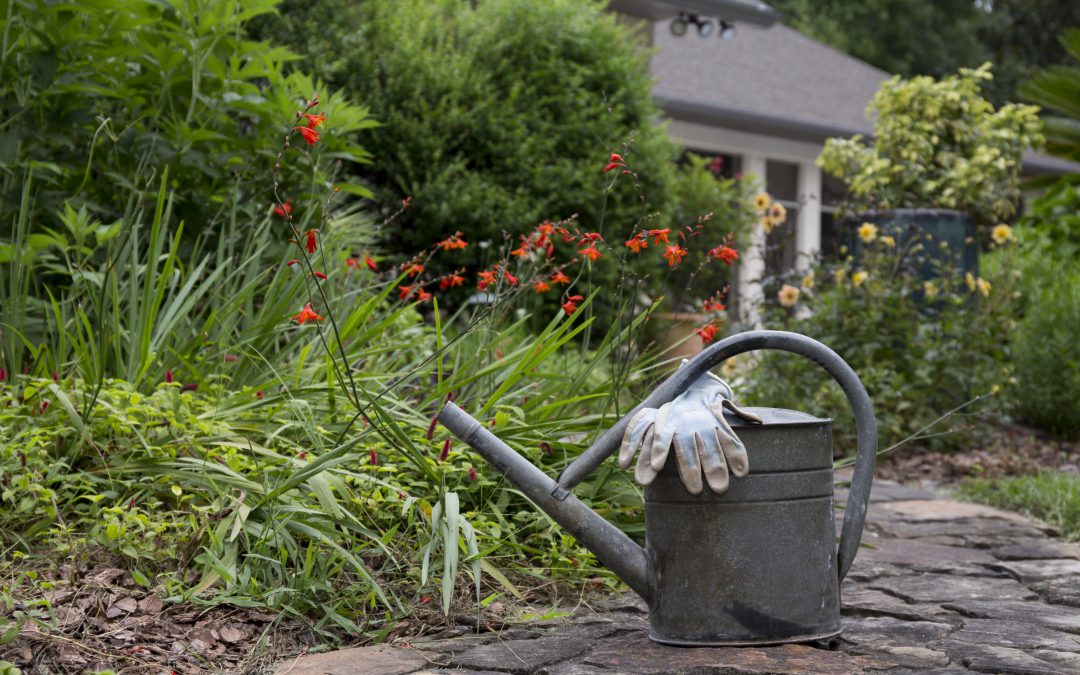
by Ray Bodrey | Jun 29, 2022
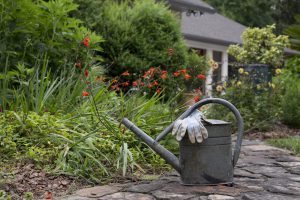
A watering tin and gardening gloves at a home garden.
Spending time gardening in the summer months can be difficult, especially in the Florida Panhandle. The brutally high temperatures and sometimes intensive humidity can make gardening seem unbearable. However, for those brave outdoor enthusiasts, there are always things to do around the homestead when it comes to vegetable gardening, landscape shrubs and lawn care.
Warm season vegetable gardening at this point becomes an uphill battle for some crops, with this being peak time for both insect and disease problems to occur. However, if you planted early enough, much of your harvest is probably in the safe zone. Scouting is key to prevent any major pest damage. Be sure to scout several times a week during these hot, summer days.
Shifting gears, the warm season is a good time to take extra special care of plants such as, azaleas and camellias, while they are establishing flower buds for the next bloom. A lack of water, fertilizer and pest detection and prevention can all certainly play a role in the following season’s flower production. Summer annuals always provide quick and easy color. Remember to feed established annuals with a complete fertilizer and remove faded blooms along the way. Water annuals well during hot, dry periods and control major annual pests to insure good production.
Finally, lawn maintenance is a need for many homeowners during this time of year. Almost all highly successful herbicides are no longer recommended at this point, as many will burn the turfgrass at temperatures above 80 degrees Fahrenheit. Depending on the weed pest and type of turfgrass, most likely the best way to control weeds in your lawn is to wait until cooler fall temperature to treat. Keeping good cultural practices this time of year will help in maintaining a healthy lawn and reduce pest pressure. Be sure to water lawns thoroughly when needed by applying one to three quarters of an inch of water weekly, depending on rainfall. Be sure to keep in mind mower height/frequency, as this is critical in keeping your lawn healthy. As stated in the “Mowing Your Florida Lawn” UF/IFAS EDIS publication, mow often enough so that no more than 1/3 of the blade height is removed per mowing. For example, if your St. Augustinegrass lawn is mowed at a height of 4 inches, it should be mowed before it grows to a height above 6 inches. It is important to always leave as much leaf surface as possible so that photosynthesis can occur, particularly in a grass that is subject to environmental or site stresses.
Unfortunately, it is chinch bug time again. Chinch bugs are prone to feed on St. Augustine lawns during hot, dry weather and may cause serious damage if not controlled. Damage usually occurs as a patch with a brown, dead center and yellowish margin. It seems chinch bugs get the blame, and often unjustly, for everything. Consult with your local county extension office to be sure the damage is not due to other reasons.
For more information, please contact your local county extension office.
Supporting information for this article can be found in the UF/IFAS EDIS publications/websites below:
Florida Vegetable Gardening Guide: https://edis.ifas.ufl.edu/publication/VH021
North Florida Gardening Calendar: https://edis.ifas.ufl.edu/publication/ep451#SECTION_7
Lawn Maintenance: https://edis.ifas.ufl.edu/entity/topic/lawn_care
Mowing Your Florida Lawn: https://edis.ifas.ufl.edu/publication/LH028
UF/IFAS Extension is an Equal Opportunity Institution.
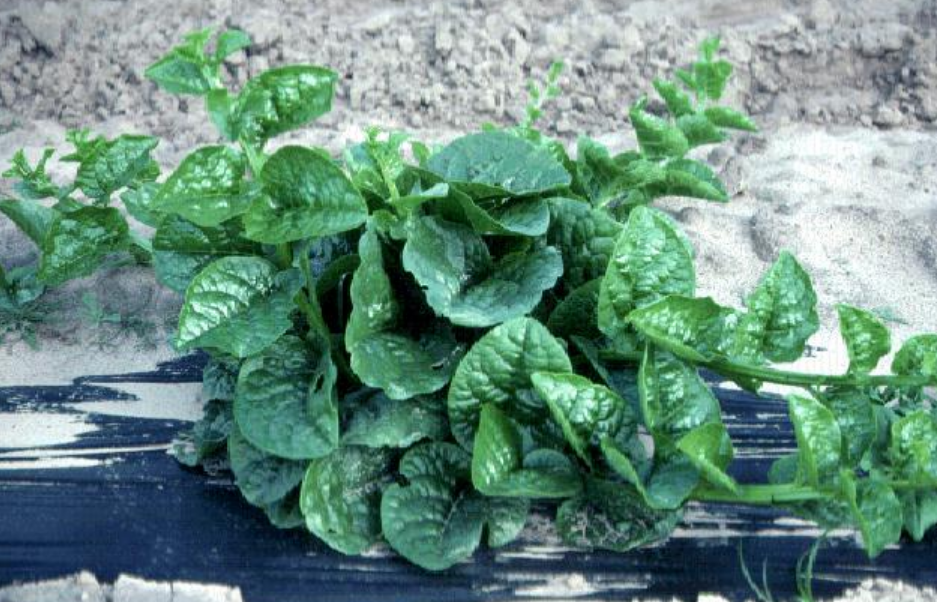
by Evan Anderson | Jun 23, 2022
Unlike areas with cooler climates, North Florida’s weather is a bit of a rollercoaster. Where the traditional four seasons allow for one growing season, the panhandle’s temperature changes create two growing seasons – spring and fall. During the winter, temperatures fall too low to keep plants happy, so those who expect to grow tropical plants in Florida may be disappointed. During the summer, the heat and humidity climb to levels that even plants can find stressful! Many of our vegetable crops simply can’t handle the extremes and wither away.
There are a few edible plants we can grow, however, that don’t seem to mind the hot weather. If you simply can’t live without a productive garden during the summer, you might consider trying these:
Cowpeas
Also called Southern peas, black-eyed peas, or field peas, these are known for their ability to produce a crop despite the harshest of conditions. Actually a bean rather than a pea, they take 65 to 125 days to grow to full maturity, depending on variety. Because they are a nitogen-fixing legume, they have also been used as a cover crop.
Malabar Spinach

Malabar Spinach. Photo Credit: James M. Stephens, UF/IFAS
Popular in Asian countries, Malabar spinach is actually a vining plant unrelated to true spinach. It grows quickly and is edible both raw and cooked, though some people may not appreciate its mucilaginous texture. Similar to okra’s sliminess, this quality does make it useful for thickening soups. Malabar spinach may be propagated from seed or by cuttings, which root easily. The plant also produces berries which, while not toxic, have very little flavor and tend to stain whatever they touch.
Okra
A traditional Southern favorite, okra takes the heat and keeps producing. Related to cotton and hibiscus, it grows pods that are ready to harvest after 60-70 days. Seeds have a tough exterior and need to be soaked overnight before planting. Harvest every couple of days at least for best results, as pods that grow too large become tough and fibrous.
Seminole Pumpkin

A Seminole pumpkin. Photo credit: UF/IFAS
Though they may need extra attention paid to them due to their attractiveness to pests, Seminole pumpkins are a great option for a summer planting. Similar to butternut squash, these cucurbits aren’t your traditional carving pumpkin, but they make great eating. Give them plenty of room to spread out in a sunny space. They take 120 days after planting before they’re ready to harvest, and their thick skin allows them to be stored for a long time after.
Sweet Potato
Does well in sandy soil? Check. Doesn’t mind the heat? Check. Sweet potatoes are great for our neck of the woods. Start out with disease-free slips for best results, and pick varieties such as ‘Beauregard’ that do well in our area.
Yardlong Beans
Related to cowpeas, yardlong beans grow on a climbing vine. The beans themselves, as the name suggests, are contained in a pod that can reach 36 inches in length. These can be picked and cooked much like green beans while the pods are still tender.

by Ashley Stonecipher | Jun 21, 2022
 Summer weeds are here. What should we do? As we are officially into summer you are probably noticing many of those summer weeds poking through your lawn by now, or perhaps they have taken over completely. Do not give up, there is still hope for a beautiful lawn with less weeds.
Summer weeds are here. What should we do? As we are officially into summer you are probably noticing many of those summer weeds poking through your lawn by now, or perhaps they have taken over completely. Do not give up, there is still hope for a beautiful lawn with less weeds.
The first thing is to be able to identify the weed and identify the type of grass. Now you may be thinking that is impossible and maybe you are thinking why it is important to identify those? The answer to that question is simply that not all chemicals are the same and understanding what you have and the best time of year to spray for that will save you both time and money. Weeds fall into three categories: Broadleaf, Grass, and Sedge. Remember, a weed could be any plant that is out of place. Weeds will compete with desirable plants for nutrients, water, light, and space.
Once you understand what category your weed falls into the next step is to know the life cycle. For example, winter annuals will die out naturally as the temperatures increase and a chemical may not be needed. There are weeds that complete their cycle in one year (winter and summer weeds) and there are weeds that complete their cycle in two years (biennials). A biennial has vegetative growth the first year and will flower and die the second year, examples are Carolina false dandelion, Oldfield toadflax, and cudweed.
Next you will want to identify the indicator species. What does this mean? It means that there are some weeds that grow well in compacted soils like goosegrass and annual bluegrass. Others like it very wet (poor drainage) such as dollar weed, sedges and torpedo grass. While there are weeds such as sandbur and rustweed that like it very dry and sandy. Knowing this can help you do preventative weed control. Grow a healthy turf starting with the right selection, proper cultural practices, pest control, traffic control, and sanitation.
When you are faced with the decision to use chemicals to combat your lawn weeds there are a few things to know. There are selective herbicides that control certain species without hurting others (your lawn) and there are nonselective herbicides that control green plants regardless of species. Also, there are contact herbicides, which are exactly how their name implies. They affect only the portion of the plant that the herbicide touches. There are also systemic herbicides which are translocated through plant’s vascular system.
The best time to spray herbicides is when the weeds are actively growing, young and not drought stressed or producing seed heads. A table below shows the active ingredients best for the three categories of weeds.
|
Broadleaf Weeds |
Grassy Weeds |
Sedge Weeds |
| Centipede |
2-4D + Dicamba +MCPP Thiencarbazone+iodosulfuron + dicamba |
Sethoxydim |
Halosulfuron-methy, Sulfentrazone, Imazaquin, Bentazon, |
| Bermuda |
2-4D + Dicamba +MCPP Thiencarbazone+iodosulfuron + dicamba |
Quinclorac |
Halosulfuron-methy, Sulfentrazone, Imazaquin, Bentazon, |
| Zoysia |
2-4D + Dicamba +MCPP Thiencarbazone+iodosulfuron + dicamba |
Fluazifop, Quinclorac |
Halosulfuron-methy, Sulfentrazone, Imazaquin, Bentazon, |
| St. Augustine |
2-4D + Dicamba +MCPP Thiencarbazone+iodosulfuron + dicamba |
None |
Halosulfuron-methy, Sulfentrazone, Imazaquin, Bentazon, |
|
**temperature restrictions |
|
|
The key is to identify the type of turf you have and the type of weeds you have in the lawn. Further, look into if there are any factors that can be adjusted that might be causing the excess of weeds. And lastly, make sure you are using the right method, chemical, and timing for control. For more information on summer weeds and lawns, please contact your local county extension office.
Information for this article can be found Managing Weeds in Warm Season Lawns | Home & Garden Information Center (clemson.edu)












